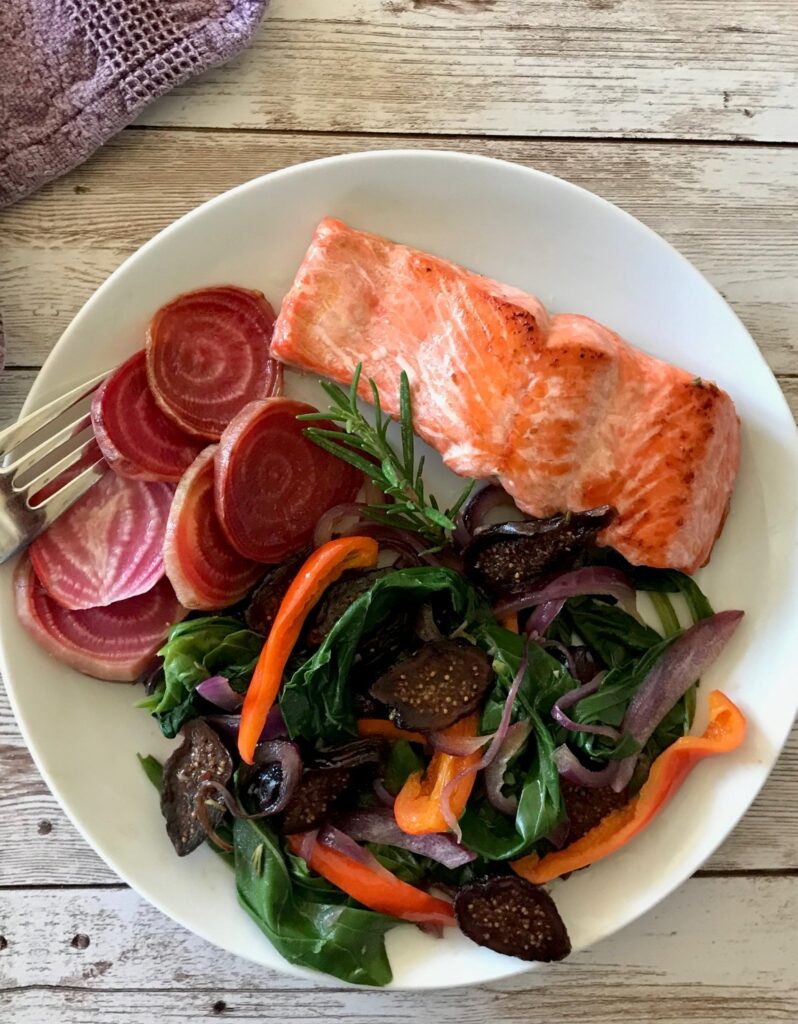Pumpkin Pie Smoothie Bowl with Figs and Seeds

What makes you choose one food over another? If your answer is “taste!”, you’re not alone.
There are many reasons we choose foods, but taste is number one, according to fifteen years of consumer research conducted by the International Food and Information Council (IFIC) (1).
Food package information, especially the Nutrition Facts Panel (NFP), is key to helping people evaluate and compare the healthfulness of foods (2). You may have noticed the updated version of the NFP currently being phased in and required on all food packages by January 2021 (3).

Key changes include:
- Some serving sizes have changed. A serving of ice cream is 2/3 cup, not ½ cup.
- Added Sugars are now listed. These are sugars added during processing of foods, foods that are packaged as sweeteners such as table sugar, syrups, honey, and sugars from concentrated fruit or vegetable juices. “Total sugars” include naturally occurring sugars (in fruits, vegetables, and milk) and “added sugars” (9).
- Potassium and vitamin D are new to the updated the nutrition label to help people recognize foods with these nutrients. Vitamins A and C are no longer required because deficiencies of these nutrients are rare.
POTASSIUM
Potassium plays a critical role in health, helping to power every heartbeat, muscle contraction and nerve transmission. As an electrolyte, a mineral with an electric charge, potassium helps maintain proper fluid levels in the blood and tissues and move nutrients and waste products in and out of cells. Getting enough potassium in your diet may offset negative effects of sodium and protect against high blood pressure, a major risk factor for heart disease and stroke. Two other key functions of potassium are to support health bones and kidney function. It may play a role in regulating blood sugar levels, too (5,6,7,8).
VITAMIN D
Best known for helping the body absorb calcium, building and maintaining bones, vitamin D has other essential functions in the body. It helps reduce inflammation and plays a role in the immune system, blood sugar metabolism, cell growth and the neuromuscular function. Many cells throughout the body have vitamin D receptors. (11).
A fat-soluble vitamin, D is sometimes called “the sunshine vitamin” because when the skin is exposed to ultraviolet light it triggers vitamin D synthesis. Too much exposure to sunlight poses a skin cancer risk and vitamin D production is less on cloudy days, if you have darker skin, wear sunscreen or live at latitudes 37 degrees north or south of the equator, except for summer months (12).
Diet is another source of vitamin D, but few foods are good sources. Rich fish such as salmon and tuna are excellent sources and mushrooms offer some. When mushrooms are exposed to ultraviolet light, they make more vitamin D, and some packaged mushrooms indicate that on the label. Most people meet vitamin D needs through fortified foods such as dairy and non-dairy milk products (10,13).

This dinner of Pan-Seared Salmon with Roasted Beets and Beet Greens Sautéed with Figs, Bell Pepper, Onion and Rosemary Beets provides 35% of the Daily Value (DV) for potassium, a whopping 80% DV vitamin D along with 15% DV calcium, 30% DV iron, 30% DV dietary fiber, 13 g protein and 450 calories.
October is pumpkin time. To satisfy my craving for pumpkin pie I created this Pumpkin Smoothie Bowl recipe. It offers 25% of the DV for potassium along with 30% DV calcium, 35% DV iron, 54% DV dietary fiber, 28 grams of protein and 500 calories. Yogurt is not usually fortified with vitamin D so this recipe doesn’t offer that nutrient. Swap in a fortified milk or non-dairy “milk” and you’ll bump up the vitamin D, which will make it a drinkable rather than spoon-able smoothie.
Not listed on the Nutrition Facts panel are phytochemicals, powerful substances in plant foods that research indicates promote health and protect against disease. The pigments that make the pumpkin and mango in this smoothie bowl recipe orange are carotenoids. Some carotenoids are precursors to vitamin A and function as antioxidants to support eye health, the immune system and protect against cardiovascular disease and cancer. Eating a variety of plant-based foods will improve your intake of phytochemicals (14).
Note: To learn more about the new Nutrition Label see How to Understand and Use the Nutrition Facts Label ,reference 9.
Disclosure: This post was adapted from an article I wrote for the Valley Fig Newsletter, Fig Focus “Potassium in Figs”. Check out the potassium-rich post-workout snack and lunch idea.

Pumpkin Smoothie Bowl with Figs and Seeds
For a cold smoothie, freeze the pumpkin or sliced mango as described below, at least a few hours ahead of making the recipe. Share or drink half and chill the other half for the next day. The figs are chewy the first day and wonderfully soft the second.
Serves 2
1 cup canned unsweetened pumpkin
1 ½ cups nonfat unflavored Greek yogurt
2/3 to 1 cup diced ripe mango
2 tablespoons maple syrup, more to taste
1 to 1 ½ teaspoons pumpkin pie spice (or mix cinnamon, cloves, nutmeg and ginger)
Pinch of salt
Toppings:
8 California dried figs, sliced
2 tablespoons pumpkin seeds
4 teaspoons black chia seeds
4 teaspoons hemp seeds
- Freeze pumpkin in ice cube trays or by this method. Place a sheet of parchment on a small ¼-sheet baking tray. Dollop 2-tablespoon portions of pumpkin onto parchment. Freeze until solid. Place in a plastic freezer bag or other airtight container and freeze until ready to use. (Or freeze diced mango pieces.)
- Combine frozen pumpkin, yogurt, mango, syrup, spice and salt in blender container. Cover and process until smooth.
- To serve, pour into two bowls. Top with fig slices, pumpkin, chia and hemp seeds. Enjoy.
References
One (1) Food and Health Survey
Two (2) IFIC Food Labeling Survey 2019
Three (3) What’s New with the Nutrition Facts Label
Four (4) Dietary Guidelines for Americans
Five (5) Four Nutrients of Concern for All Americans
Six (6) Micronutrients: Potassium Kathleen Zelman. April 30, 2018. Food & Nutrition Magazine
Seven (7) Potassium Fact Sheet foodinsight.org
Nine (9) How to Understand and Use the Nutrition Facts Label https://www.fda.gov/food/new-nutrition-facts-label/how-understand-and-use-nutrition-facts-label
Ten (10) Vitamin D Fact Sheet for Health Professionals
Eleven (11) Staying Healthy: Time for More Vitamin D
Twelve (12) Vitamin D Fact Sheet for Consumers
Fourteen (14) Fill Up on Phytochemicals. February 2010 Harvard Health Letter.
© Lorelle Del Matto 2020
 About lorelle
About lorelle
Speak Your Mind